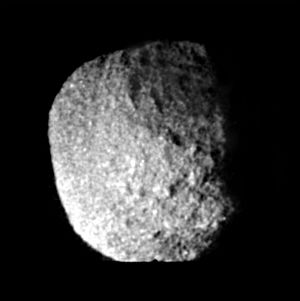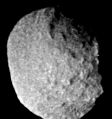Proteus (moon) facts for kids
 |
|
| Discovery | |
|---|---|
| Discovered by | Voyager 2 Stephen P. Synnott |
| Discovery date | ~June 16, 1989 |
| Orbital characteristics | |
| Epoch 18 August 1989 | |
| Periapsis | 117,584 ± 10 km |
| Apoapsis | 117,709 ± 10 km |
| 117,647 ± 1 km (0.00079 AU) | |
| Eccentricity | 0.00053 ± 0.00009 |
| 1.12231477 ± 0.00000002 d | |
|
Average orbital speed
|
7.623 km/s |
| Inclination | 0.524° (to Neptune equator) 0.026 ± 0.007° (to local Laplace plane) |
| Satellite of | Neptune |
| Physical characteristics | |
| Dimensions | 440×416×404 km (± ~15 km) |
| Volume | 3.4 ± 0.3 ×107km³ |
| Mass | ~4.4×1019 kg (estimate) |
|
Mean density
|
~1.3 g/cm³ (estimate) |
| ~0.06 m/s2 (0.006 g) | |
| ~0.16 km/s | |
| synchronous | |
| zero | |
| Albedo | 0.096 |
| Temperature | ~51 K mean (estimate) |
| 20.3 | |
Proteus, also known as Neptune VIII, is the second largest moon of Neptune. It is also the biggest moon that orbits close to Neptune. This moon is named after Proteus, a sea god from Greek mythology who could change his shape.
Discovery of Proteus
Proteus was discovered in 1989 by the Voyager 2 space probe. The probe took many pictures during its flyby of Neptune. Scientists Stephen P. Synnott and Bradford A. Smith announced its discovery on July 7, 1989. They looked at 17 images taken over 21 days. This means the moon was first seen sometime before June 16, 1989. It was first called S/1989 N 1. The official name "Proteus" was given on September 16, 1991.
Size and Appearance
Proteus is a large moon, measuring more than 400 kilometers across. This makes it bigger than Nereid, another one of Neptune's moons. Even though it's so big, scientists on Earth couldn't see it with telescopes. This is because Proteus orbits very close to Neptune. The bright sunlight reflecting off the planet made it impossible to spot the moon.
Proteus is one of the darkest objects in our Solar System. It's like Saturn's moon Phoebe. Proteus reflects only about 6 percent of the sunlight that hits it. This means it's very dim.
Surface Features
The surface of Proteus is covered in many craters. These are marks left by impacts from other objects in space. The moon shows no signs of any geological changes. This means there are no volcanoes or shifting land on its surface.
Proteus is also not perfectly round. Scientists believe it's about as big as a moon can get without its own gravity pulling it into a perfectly spherical shape. For example, Saturn's moon Mimas is smaller than Proteus but looks much more like a perfect sphere.
Images for kids
See also
 In Spanish: Proteo (satélite) para niños
In Spanish: Proteo (satélite) para niños



